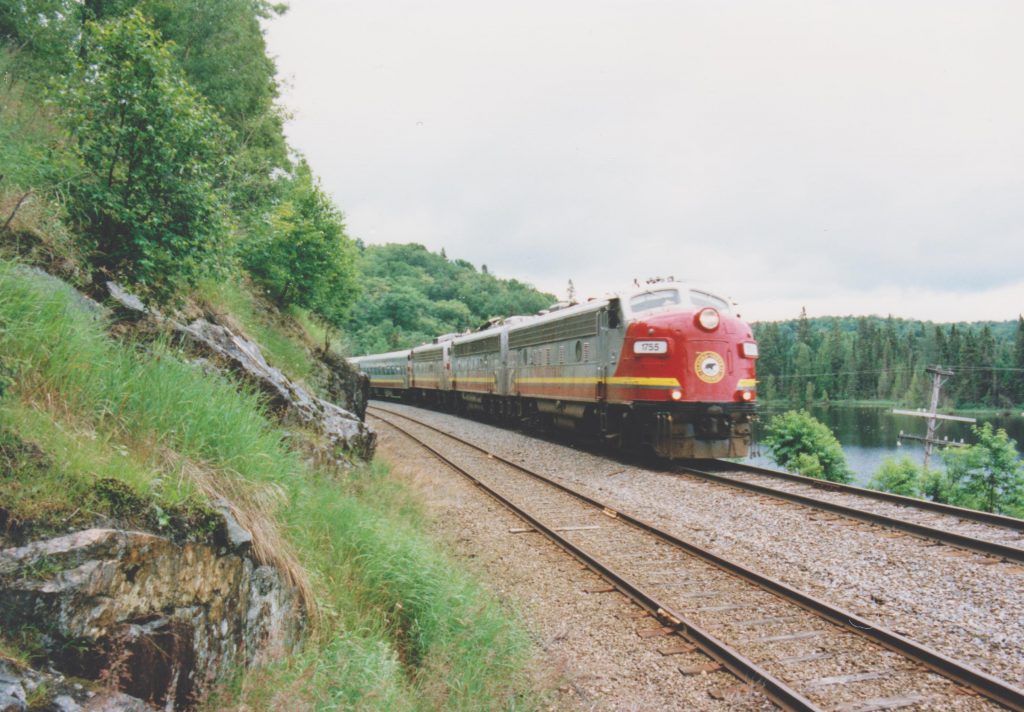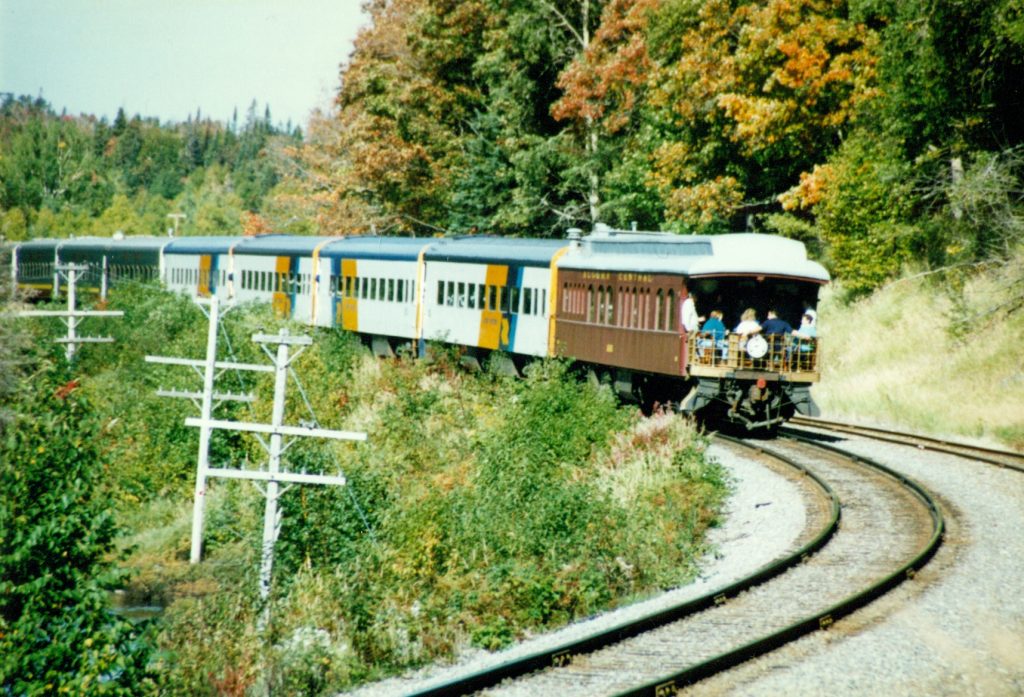




As a follow-up to my previous post on the ACR’s standard design section house, here’s a collection of additional still surviving section houses along the line. Many of these are now private cottages, and a few farther to the north on the railway are simply abandoned.
Typical design. Now a private cabin. The sign hanging off of the porch roof identifies it as “The Ranch”. Notice that this house has a shallower roof pitch than most of the others, matching a 1/3 roof pitch shown on standard drawings.
Another view of Northland Section in 1988, before the trees screened some of the view, from Ted Ellis’s site.
Achigan section has received some renovations with a replaced roof, siding and windows. Looks like the kitchen needs a little work yet. This shows a steeper roof pitch than the 1/3 shown in the standard drawing and the Northland section house above.
Achigan in 1974 (Ted Ellis)
Batchewana is one of the last places south of Canyon that still have both an active full-length siding and a surviving section house structure. This is another almost original structure, although the owner of the house has enclosed the porch into a sunroom.
Batchewana section in 1970 (Ted Ellis)
This was the location of a forestry service fire base, and there are quite a number of other buildings located here pretty much all of which are privately owned cabins today. There was no ACR siding at this location, but the outline of the standard section house is unmistakable, even with new siding and windows.
Rand, 1979 (Ted Ellis)
This is another former section house that has received some extensive renovations in private ownership. It (and its associated sheds) have all received new metal roofing, new siding and upgraded windows. This cottage definitely appears to be in nice shape.
Frater’s section house was located a little farther back from the rails, across the parking area for Frater station, which was formerly located just to the south. (The station was demolished several years ago.) Frater is one of the few places along the line with easy road access, with the nearest proper highway access (other than unimproved logging roads) being 50+ miles to the north or south.
The former Canyon section house is now used as the Park Ranger’s bunkhouse and first aid station at Agawa Canyon Park.
The rough-edged wood siding, giving this structure a more rustic look, is not original. This structure once had the same sort of milled siding as found on the other typical ACR section houses.
The section house at Eton is now a private rental lodge. It’s seen some alterations with the front porch enclosed making a sun room, an enlarged first floor window on the south side, an extended deck and a large addition on the north side of the structure, but otherwise this structure still exhibits the typical look of ACR section houses. It also appears to have been relocated from an original location lower and closer to the tracks.
Eton is the first siding north of Canyon and still remains in service as an active siding. There is also currently quite an active pulpwood loading spur near the north end of Eton siding.
There is no siding at this location, just this lonely section house, which is now a private cabin. Another typical design, very close to the standard drawing and almost identical to Agawa, Mashkode and Batchewana except for window and door locations on the kitchen annex.
Another section house that is now privately owned. The front porch has been gussied up a bit with a lattice railing, and the stonework chimney on the south side of the structure is an alteration. You can see a cap in the middle of the roof line where the original centrally located brick chimney would have been.
The kitchen extension on this section house is definitely unusual, being full width across the back of the structure and having a peaked gabled roof, instead of a simple slanting lean-to roof that would be common on other section houses.
Perry, 1988 (Ted Ellis)
Another fairly typical section house with a large rear annex, although the window locations vary a bit from most other section houses. This building was replaced by a newer one story crew bunkhouse nearby, and is now boarded up and disused. Franz is another example with a shallower roof pitch similar to the drawing in the Sault Public Library Archives.
This abandoned bunk house at Oba has probably the most unusual siding treatment, being covered in tan asphalt “insul-brick” below the eaves and grey shingles on the gable end. Rolled roofing instead of shingles is also unusual compared to other examples. The chimney also appears to be located to the rear of the main structure instead of the exact centre along the ridge line.
Trees and bushes growing in around the derelict structure make it hard to tell if it even has a rear annex, although this would be particularly unusual for the kitchen annex to not be present.
To finish off, here’s a few more section house locations not covered above from Ted Ellis. If any of these actually still exist today, I was looking out the wrong side of the train when we passed and didn’t see them.
And that would seem to be about it for prototype section houses for now. With some various simple sheds tackled, I’m ready to get into building one or two of these bunkhouses, starting with a new model of the Franz section house with proper dimensions.
Stay tuned…
Earlier this summer I acquired a small collection of ACR images from an individual in the states. The slides appear to have been primarily taken on the occasion of a railfan visit to the Algoma Central, and while of varying quality, contain some interesting content. The photographer appears to have gotten a cab ride (in a trailing unit) on both a northbound and southbound freight over the Soo subdivision, a caboose ride on an ore train on the Michipicoten branch and on the Northern sub (at least as far as Franz).
None of the slides were marked for location, date or photographer’s name, making identification a little interesting in some cases. However most of the slides had numbers written on the slide mounts allowing them to be put into proper sequence, at which point a story unfolded and certain views could this be related to each other. My own ride on the Tour of the Line at the beginning of October also helped to familiarize myself with the line and I could thus confirm a few of the location identities.
While the slides are undated, a few items have allowed me to date the images to the winter of 1980-81 with a pretty high degree of certainty. One image in the collection is of baggage car 211, which was renumbered 302 in the spring of 1981 with the arrival of the 200-205 series GP38-2 locomotives. Another image of the ACR’s scale test car clearly shows a 5-80 reweigh date on the car, which pretty nicely brackets the time frame of the images to a specific year.
The background thus identified, here follows a few selections of interest, in no particular order.
Scale house at Steelton yard. The ground level window on the rear of the structure seems an odd feature. In the background is the ACR’s sprawling Steelton yard and the Algoma Steel Corporation mill. Several AC freight cars including one of the ACR’s unique 61′ bulkhead gondolas, an even more unique curved side “bathtub” style hopper and a covered gondola for coil steel service are visible.
Frater station. In deep snow with snowmobile tracks all over. There are other better photos of the station building at Frater available online, but this nicely relates the station to the two small outbuildings behind. The station has long been torn down, but those two small structures still exist today. The grey structure appears to have been converted into a small cabin; note the new “bay window” added to the front of this structure, which appears to be salvaged material from the station.
The location for the above photo would appear to also be at Frater, just south of the station, showing a northbound freight running along the shore of Frater Lake. Note the long string of CP 40′ boxcars in the train; at least a dozen can be counted before the train curves away. Likely these are empties heading back to Schreiber on the CPR for woodpulp loading. This is an interesting photo for highlighting the volume of this traffic over the ACR.
Crossing the CPR at Franz, riding in the caboose of a northbound freight. More CP 40′ boxcars are spotted in the interchange track; one is painted in green which signified newsprint service. All of the cars seen here are probably 8′ door cars (all the newsprint assigned cars were 8 footers) in service hauling woodpulp from mills along the Lake Superior north shore.
Speaking of Franz, here’s a look southward off the rear of that caboose:
All of the structures visible in the above photo, except for a small white speeder shed roughly in the centre of the photo, still stand today. The station at Franz was closed in 1992 with the end of train order operation on the ACR, and ended up being moved to the community of Dubreuilville.
The above photo was tentatively identified as the ballast pit just north of Perry siding, based on the excavated appearance of the embankment in the background and its sequence number and relation to other images/locations. This was able to be conclusively confirmed when I rode the ACR passenger train on the last day of September and easily recognized the location.
The above images makes it a little unclear whether any ballast was still quaried from the gravel pit here during the 1980s, but interestingly there was clearly quite an active pulpwood loadout here during this time frame.
Perry pit today, the rails for the spur are still there, but the main track switch has been removed and the site is abandoned:
A simple passenger shelter at Millwood (mile 212.9). Simple shelters like this were erected at several flag stop locations along the line.
That’s all for tonight, probably more to come periodically.